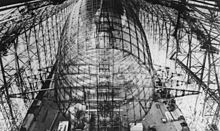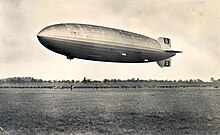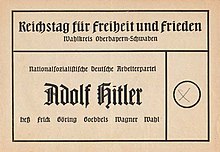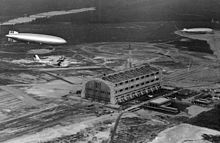LZ 129 Hindenburg
| LZ 129 Hindenburg | |
|---|---|
Deutsche Zeppelin Reederei | |
| Registration | D-LZ129 |
| Radio code | DEKKA[1] |
| Flights | 63[2] |
| History | |
| Manufactured | 1931–1936 |
| First flight | March 4, 1936 |
| In service | 1936–1937 |
| Last flight | May 6, 1937 |
| Fate | Destroyed in fire and crash |
LZ 129 Hindenburg (Luftschiff Zeppelin #129;
The airship flew from March 1936 until it was
Design and development
The Zeppelin Company had proposed LZ 128 in 1929, after the world flight of the LZ 127 Graf Zeppelin. This ship was to be approximately 245 m (804 ft) long and carry 140,000 cubic metres (4,900,000 cu ft) of hydrogen. Ten Maybach engines were to power five tandem engine cars (a plan from 1930 showed only four). The disaster of the British airship R 101 prompted the Zeppelin Company to reconsider the use of hydrogen, therefore scrapping the LZ 128 in favour of a new airship designed for helium, the LZ 129. Initial plans projected the LZ 129 to have a length of 248 metres (814 ft), but 11 m (36 ft) was dropped from the tail in order to allow the ship to fit in Lakehurst Hangar No. 1.[4]

Manufacturing of components began in 1931, but construction of the Hindenburg did not commence until March 1932. The delay was largely due to
Hindenburg had a duralumin structure, incorporating 15 Ferris wheel-like main ring bulkheads along its length, with 16 cotton gas bags fitted between them. The bulkheads were braced to each other by longitudinal girders placed around their circumferences. The airship's outer skin was of cotton doped with a mixture of reflective materials intended to protect the gas bags within from radiation, both ultraviolet (which would damage them) and infrared (which might cause them to overheat). The gas cells were made by a new method pioneered by Goodyear using multiple layers of gelatinized latex rather than the previous goldbeater's skins. In 1931 the Zeppelin Company purchased 5,000 kg (11,000 lb) of duralumin salvaged from the wreckage of the October 1930 crash of the British airship R101.[5]


Hindenburg's interior furnishings were designed by Fritz August Breuhaus, whose design experience included Pullman coaches, ocean liners, and warships of the German Navy.[6] The upper "A" Deck contained 25 small two-passenger cabins in the middle flanked by large public rooms: a dining room to port and a lounge and writing room to starboard. Paintings on the dining room walls portrayed the Graf Zeppelin's trips to South America. A stylized world map covered the wall of the lounge. Long slanted windows ran the length of both decks. The passengers were expected to spend most of their time in the public areas, rather than their cramped cabins.[7]
The lower "B" Deck contained washrooms, a
Use of hydrogen instead of helium
Despite a U.S. ban on the export of helium under the Helium Control Act of 1927,[14] the Germans designed the airship to use the far safer gas in the belief that they could convince the U.S. government to license its export. When the designers learned that the National Munitions Control Board refused to lift the export ban, they were forced to re-engineer Hindenburg to use flammable hydrogen gas, which was the only alternative lighter-than-air gas that could provide sufficient lift.[11] One of the side benefits of being forced to utilize the flammable yet lighter hydrogen was that more passenger cabins could be added.
Operational history
Launching and trial flights

Four years after construction began in 1932, Hindenburg made its
The name Hindenburg lettered in 1.8-metre (5 ft 11 in) high red

The airship was operated commercially by the
After a total of six flights made over a three-week period from the Zeppelin dockyards where the airship had been built, Hindenburg was drafted — over Hugo Eckener's objections — for a formal public debut in a 6,600 km (4,100 mi) Nazi Party propaganda flight around Germany (Die Deutschlandfahrt) made jointly with the Graf Zeppelin from March 26 to 29.
Die Deutschlandfahrt

Although designed and built for commercial transatlantic passenger, air freight, and mail service, at the behest of the

In order to justify its
The Zeppelin Company chairman, Dr. Hugo Eckener, disapproved of this propaganda use of his craft. According to American reporter William L. Shirer, "Hugo Eckener, who is getting [the Hindenburg] ready for its maiden flight to Brazil, strenuously objected to putting it in the air this weekend on the ground it was not fully tested, but Dr. Goebbels insisted. Eckener, no friend of the regime, refused to take it up himself, but allowed Captain [Ernst] Lehmann to. [Goebbels] is reported howling mad and is determined to get Eckener."[29]
While gusty wind conditions on the morning March 26 threatened a safe launch of the new airship, Hindenburg's commander, Captain
Graf Zeppelin, which had been hovering above the airfield waiting for Hindenburg to join it, had to start off on the propaganda mission alone while LZ 129 returned to her hangar. There temporary repairs were quickly made to its empennage before joining up with the smaller airship several hours later.[33] As millions of Germans watched from below, the two giants of the sky sailed over Germany for the next four days and three nights, dropping propaganda leaflets, blaring martial music and slogans from large loudspeakers, and broadcasting political speeches from a makeshift radio studio aboard Hindenburg.[34]
On March 29, as German citizens voted overwhelmingly in favor of the Rhineland re-occupation, the Hindenburg was aloft over Berlin. Later, Hugo Eckener privately mocked Goebbels by telling friends, "There were forty persons on the Hindenburg. Forty-two 'yes' votes were counted." William Shirer recorded: "Goebbels has forbidden the press to mention Eckener's name."[35]
First commercial passenger flight


With the completion of voting on the referendum (which the German Government claimed had been approved by a "98.79% 'Yes' vote"),[36][37] Hindenburg returned to Löwenthal on March 29 to prepare for its first commercial passenger flight, a transatlantic passage to Rio de Janeiro scheduled to depart from there on March 31.[38] Hugo Eckener was not to be the commander of the flight, however, but was instead relegated to being a "supervisor" with no operational control over Hindenburg while Ernst Lehmann had command of the airship.[39] To add insult to injury, Eckener learned from an Associated Press reporter upon Hindenburg's arrival in Rio that Goebbels had also followed through on his month-old threat to decree that Eckener's name would "no longer be mentioned in German newspapers and periodicals" and "no pictures nor articles about him shall be printed."[40] This action was taken because of Eckener's opposition to using Hindenburg and Graf Zeppelin for political purposes during the Deutschlandfahrt, and his "refusal to give a special appeal during the Reichstag election campaign endorsing Chancellor Adolf Hitler and his policies."[41] The existence of the ban was never publicly acknowledged by Goebbels, and it was quietly lifted a month later.[42]
While at Rio, the crew noticed one of the engines had noticeable carbon buildup from having been run at low speed during the propaganda flight days earlier. For the rest of April, Hindenburg remained at its hangar where the engines were overhauled and the lower fin and rudder received a final repair; the ground clearance of the lower rudder was increased from 8 to 14 degrees.
1936 transatlantic season


Hindenburg made 17 round trips across the
In May and June 1936, Hindenburg made surprise visits to England. In May it was on a flight from America to Germany when it flew low over the
In July 1936, Hindenburg completed a record Atlantic round trip between Frankfurt and Lakehurst in 98 hours and 28 minutes of flight time (52:49 westbound, 45:39 eastbound).[51] Many prominent people were passengers on the Hindenburg, including boxer Max Schmeling making his triumphant return to Germany in June 1936 after his world heavyweight title knockout of Joe Louis at Yankee Stadium.[52][53][54] In the 1936 season, the airship flew 191,583 miles (308,323 km) and carried 2,798 passengers and 160 tons of freight and mail, encouraging the Luftschiffbau Zeppelin Company to plan the expansion of its airship fleet and transatlantic service.[citation needed]
The airship was said to be so stable a pen or pencil could be balanced on end atop a table without falling. Launches were so smooth that passengers often missed them, believing the airship was still docked to the
On October 8, 1936, Hindenburg made a 10.5 hour flight (the "Millionaires Flight") over
During 1936, Hindenburg had a
Hindenburg also had an experimental aircraft hook-on
Final flight: May 3–6, 1937
After making the first South American flight of the 1937 season in late March, Hindenburg left Frankfurt for Lakehurst on the evening of 3 May, on its first scheduled round trip between Europe and North America that season. Although strong headwinds slowed the crossing, the flight had otherwise proceeded routinely as it approached for a landing three days later.[63]
Hindenburg's arrival on 6 May was delayed for several hours to avoid a line of thunderstorms passing over Lakehurst, but around 7:00 pm the airship was cleared for its final approach to the Naval Air Station, which it made at an altitude of 200 m (660 ft) with Captain
The exact location of the initial fire, its source of ignition, and the source of fuel remain subjects of debate. The cause of the accident has never been determined conclusively, although many hypotheses have been proposed. Sabotage theories notwithstanding, one hypothesis often put forth involves a combination of gas leakage and atmospheric static conditions. Manually controlled and automatic valves for releasing hydrogen were located partway up one-meter diameter ventilation shafts that ran vertically through the airship.[69] Hydrogen released into a shaft, whether intentionally or because of a stuck valve, would have mixed with air already in the shaft — potentially in an explosive ratio. Alternatively, a gas cell could have been ruptured by the breaking of a structural tension wire causing a mixing of hydrogen with air.[70] The high static charge collected from flying within stormy conditions and inadequate grounding of the outer envelope to the frame could have ignited any resulting gas-air mixture at the top of the airship.[71] In support of the hypothesis that hydrogen was leaking from the aft portion of the Hindenburg prior to the conflagration, water ballast was released at the rear of the airship and six crew members were dispatched to the bow to keep the craft level.
Another more recent theory involves the airship's outer covering. The silvery cloth covering contained material with
The
-
A partially burned piece of mail from the Hindenburg's last flight
-
Hindenburg on fire
-
A fire-scorched duralumin Hindenburgcross bracesalvaged from the crash site
Appearances in media

- Charlie Chan was a passenger aboard the Hindenburg in the 1937 film Charlie Chan at the Olympics.
- An image of the burning airship was used as the cover of Led Zeppelin's self-titled debut album (1969).[76]
- The Hindenburg is a 1975 film inspired by the disaster, but centered on the sabotage theory. Some of these plot elements were based on real bomb threats before the flight began, as well as proponents of the sabotage theory. The actual model from the movie is now on permanent display in the National Air and Space Museum in Washington, D.C.
- In The Waltons 1977 episode "The Inferno", John Boy Walton is sent by a publication to cover the New Jersey landing, and is traumatized by witnessing the event.
- Hindenburg: The Last Flight is a 2011 German TV miniseries directed by Philipp Kadelbach. Like the 1975 film, it also focuses on the sabotage theory; the plot is about a young engineer who uncovers a plot to blow up the Hindenburg while the German airship is preparing for its maiden voyage to America.
Specifications

Data from Airships: A Hindenburg and Zeppelin History site[3]
General characteristics
- Crew: 40 to 61
- Capacity: 50–70[60] passengers
- Length: 245 m (803 ft 10 in)
- Diameter: 41 m (135 ft 1 in)
- Volume: 200,000 m3 (7,062,000 cu ft)
- Powerplant: 4 × Daimler-Benz DB 602 (LOF-6) V-16 diesel engines, 890 kW (1,200 hp) each
Performance
- Maximum speed: 135 km/h (85 mph, 74 kn)
- Cruise speed: 122 km/h (76 mph, 66 kn)
See also
- Timeline of hydrogen technologies
- The Zeppelin Museum Friedrichshafen displays a reconstruction of a 33 m section of the Hindenburg.
Citations
- ISBN 978-3-319-55247-7.
- ^ List of Flights by D-LZ129 Hindenburg Airships.net
- ^ a b "Hindenburg Statistics." airships.net, 2009. Retrieved: July 22, 2017.
- ^ ISBN 978-0750969956.
- ^ "R101: the Final Trials and Loss of the Ship." The Airship Heritage Trust. Retrieved October 27, 2010.
- ^ Lehmann 1937, p. 319.
- ^ Dick and Robinson 1985, p. 96.
- ^ "The Goodyear Zeppelin Company." Ohio History Central. Retrieved October 27, 2010.
- ^ Dick and Robinson 1985, p. 97.
- ^ "LZ-129 The Latest Airship," Popular Mechanics, June 1935.
- ^ a b c MacGregor, Anne. "The Hindenburg Disaster: Probable Cause" (Documentary film). Moondance Films/Discovery Channel, Broadcast air date: 2001.
- ^ Grossman, Dan. "Hindenburg Design and Technology". Airships.net. Retrieved June 9, 2015.
- ^ Vaeth 2005, p. 38.
- ^ Sears 2015, pp. 108–113.
- ^ Lehmann 1937, p. 323.
- ^ "The Airship." British Quarterly Journal, Spring 1935.
- ISBN 9783954003013.
- ^ "Today in History: Hindenburg’s First Flight, March 4, 1936." Airships.net. Retrieved October 27, 2010.
- ^ "Deutsche Zeppelin-Reederei (DZR)". Airships.net. Retrieved October 27, 2010.
- ^ Lehmann 1937, pp. 323–332.
- ^ Lehmann 1937, p. 341.
- ^ "Hindenburg Begins First U.S. Flight." New York Times, May 7, 1936.
- ^ "Hindenburg is off on 2d U.S. Flight." New York Times, May 17, 1936.
- ^ "Hindenburg Flight Schedules." Airships.net. Retrieved October 27, 2010.
- ^ "Propaganda 'attack' made by Zeppelins." The New York Times, March 29, 1936.
- ^ "Belgium Insistent on Locarno Terms", The New York Times, March 12, 1936.
- ^ "Two Reich Zeppelins on Election Tour", The New York Times, March 27, 1936.
- ^ Photograph of Hindenburg and Graf Zeppelin preparing to depart Löwenthal on Die Deutschlandfahrt. specialcollections.wichita.edu. Retrieved January 11, 2010.
- ^ William L. Shirer, Berlin Diary, ©1941 reprinted 2011 by Rosetta Books, entry for March 29, 1936
- ^ Lehmann 1937, p. 326.
- ^ Photograph by Harold Dick of damaged lower vertical tail fin. specialcollections.wichita.edu. Retrieved January 11, 2010.
- ^ Eckener 1958, pp. 150–151.
- ^ "Photograph by Harold Dick of temporary repair to lower vertical tail fin." specialcollections.wichita.edu. Retrieved January 11, 2010.
- ^ Lehmann 1937, pp. 326–332.
- ^ Berlin Diary, entry for April 1936 (undated)
- ^ "Hitler gets biggest vote: Many blanks counted in, 542,953 are invalidated. Some 'Noes' Not Counted; Confusion Causes Counting of Blanks and Many May Have Shown Opposition". The New York Times, March 30, 1936.
- ^ "Foreign News: May God Help Us!" Time, April 6, 1936
- ^ Mooney 1972, pp. 82–85.
- ^ "Transport: Von Hindenburg to Rio." Time, April 13, 1936.
- ^ Mooney 1972, p. 86.
- ^ "Eckener Refused Election Plea for Hitler: Name Barred From the Press as a Result." The New York Times, April 3, 1936.
- ^ "'Eckener's Disgrace Ends: Zeppelin Expert is Victor in Clash with Goebbels." The New York Times, April 30, 1936.
- ^ Dick and Robinson 1985, p. 119.
- ^ Dick and Robinson 1985, p. 118.
- ^ "Two Motors Crippled as Zeppelin Lands." The New York Times, April 11, 1936.
- ^ Lehmann 1937, pp. 341–342.
- ^ Lehmann 1937, p. 343.
- ^ George Bagshawe Harrison (1938), The Day Before Yesterday: Being a Journal of the Year 1936, Cobden-Sanderson, p. 121
- ^ "Flowers from Airship: "First Flying Priest's" Request", The Citizen, 61 (20), Gloucester: 4, May 23, 1936
- ISBN 1903783224
- ^ "Hindenburg Flight Schedule" Airships.net
- ^ "Max Schmeling on the Hindenburg" Airships.net
- ^ "SCHMELING HOME, HAILED BY REICH Planes Soar Over Hindenburg to Greet Boxer Who Was Ignored on Departure" The New York Times, June 27, 1936
- ^ Berg, Emmett. "Fight of the Century." Archived March 10, 2014, at the Wayback Machine Humanities, Vol. 25, No. 4, July/August 2004. Retrieved: January 7, 2008.
- ^ Grossman, Dan. "Hindenburg's Maiden Voyage Passenger List" Airships.net. Retrieved: May 9, 2010.
- ^ Toland 1972, p. 9.
- ^ Birchall 1936
- ^ Grossman, Dan. "Hindenburg "Millionaires Flight"". Airships.net. Retrieved June 12, 2017.
- ^ "A History of the Blüthner Piano Company" Archived February 6, 2007, at the Wayback Machine bluthnerpiano.com. Retrieved: January 7, 2008.
- ^ a b "The Hindenburg's Interior: Passenger Decks".
- ISBN 9783895494017.)
{{cite book}}: CS1 maint: location missing publisher (link - ^ Dick and Robinson 1985, pp. 142–145.
- ^ a b Yoon, Joe (June 18, 2006). "Cause of the Hindenburg Disaster". Aero Space web. Retrieved January 11, 2010.
- ^ Hindenburg Disaster Passenger List Airships.net
- ^ Hindenburg Disaster – List of Officers and Crew Airships.net
- ^ Thompson, Craig. "Airship Like a Giant Torch On Darkening Jersey Field: Routine Landing Converted Into Hysterical Scene in Moment's Time—Witnesses Tell of 'Blinding Flash' From Zeppelin." The New York Times, May 7, 1937.
- ^ "The Hindenburg Disaster." Airships.net. Retrieved October 27, 2010.
- ^ Morrison, Herbert. Live radio account of arrival and crash of Hindenburg. Radio Days via OTR.com. Retrieved October 27, 2010.
- ^ Air Commerce Bulletin of August 15, 1937 (vol. 9, no. 2) published by the United States Department of Commerce
- ^ "The Hindenburg Accident. A Comparative Digest of the Investigations and Findings With the American and Translated German Reports Included." R.W. Knight, Acting Chief, Air Transport Section. U.S. Department of Commerce, Bureau of Air Commerce, Safety and Planning Division, Report No. 11, August 1938.
- ^ Report of the German Investigation Commission about the Accident of the Airship "Hindenburg" on May 6, 1937, at Lakehurst, U.S.A.
- ^ Bokow, Jacquelyn Cochran (1997). "Hydrogen Exonerated in Hindenburg Disaster". National Hydrogen Association. Archived from the original on January 13, 2010. Retrieved January 11, 2010.
The NHA's mission is to foster the development of hydrogen technologies and their utilization in industrial, commercial, and consumer applications and promote the role of hydrogen in the energy field.
- ^ a b Dessler, A. J. (June 3, 2004). "The Hindenburg Hydrogen Fire: Fatal Flaws in the Addison Bain Incendiary-Paint Theory" (PDF). John Dziadecki, Libraries Webmaster, University of Colorado, Boulder. Retrieved January 13, 2012.
- ^ Grossman, Dan (October 2010). "Hydrogen Airship Disasters". airships.net. Retrieved January 13, 2012.
- ^ Mooney 1972, p. 262.
- ^ Davis 1995, pp. 32, 44.
General sources
- Airships.net LZ-129 Hindenburg
- Airship Voyages Made Easy (16 page booklet for "Hindenburg" passengers). Friedrichshafen, Germany: Luftschiffbau Zeppelin G.m.b.H. (Deutsche Zeppelin-Reederei), 1937.
- Archbold, Rick. Hindenburg: An Illustrated History. Toronto: Viking Studio/Madison Press, 1994. ISBN 0-670-85225-2.
- Birchall, Frederick. "100,000 Hail Hitler; U.S. Athletes Avoid Nazi Salute to Him". The New York Times, August 1, 1936, p. 1.
- Botting, Douglas. Dr. Eckener's Dream Machine: The Great Zeppelin and the Dawn of Air Travel. New York: Henry Holt & Co., 2001. ISBN 0-8050-6458-3.
- Davis, Stephen. Hammer of the Gods: The Led Zeppelin Saga (LPC). New York: Berkley Boulevard Books, 1995. ISBN 0-425-18213-4.
- Dick, Harold G. and Douglas H. Robinson. The Golden Age of the Great Passenger Airships Graf Zeppelin & Hindenburg. Washington, D.C.: Smithsonian Institution Press, 1985. ISBN 1-56098-219-5.
- Duggan, John. LZ 129 "Hindenburg": The Complete Story. Ickenham, UK: Zeppelin Study Group, 2002. ISBN 0-9514114-8-9.
- Eckener, Hugo, translated by Douglas Robinson. My Zeppelins. London: Putnam & Co. Ltd., 1958.
- Hindenburg's Fiery Secret (DVD). Washington, D.C.: National Geographic Video, 2000.
- Hoehling, A.A. Who Destroyed The Hindenburg? Boston: Little, Brown and Company, 1962. ISBN 0-445-08347-6.
- Lehmann, Ernst. Zeppelin: The Story of Lighter-than-air Craft. London: Longmans, Green and Co., 1937.
- Majoor, Mireille. Inside the Hindenburg. Boston: Little, Brown and Company, 2000. ISBN 0-316-12386-2.
- Mooney, Michael Macdonald. The Hindenburg. New York: Dodd, Mead & Company, 1972. ISBN 0-396-06502-3.
- Provan, John. LZ-127 "Graf Zeppelin": The story of an Airship, vol. 1 & vol. 2 (Amazon Kindle ebook). Pueblo, Colorado: Luftschiff Zeppelin Collection, 2011.
- Sears, Wheeler M. "Bo" Jr. (2015). Helium: The Disappearing Element. New York: Springer. ISBN 9783319151236.
- Toland, John. The Great Dirigibles: Their Triumphs and Disasters. Mineola, New York: Dover Publishers, 1972.
- Vaeth, Joseph Gordon. They Sailed the Skies: U.S. Navy Balloons and the Airship Program. Annapolis Maryland: Naval Institute Press, 2005. ISBN 978-1-59114-914-9.
External links
- The short film Giant Dirigible Sets Record, 1936/05/11 (1936) is available for free viewing and download at the Internet Archive.
- Hindenburg – End Of A Successful Voyage (Standard 4:3) (1937), Pathgrams (film shows docking team, passengers)
- Hindenburg – Passengers Disembarking (Standard 4:3) (1937), Pathgrams (film of passengers descending ramp)
- Detailed Technical Drawing of the LZ 129 Hindenburg
- Airships.net: Detailed history and photographs of interior and exterior of LZ-129 Hindenburg
- "The Hindenburg Makes Her Last Landing at Lakehurst", Life Magazine article from 1937
- eZEP.de, The webportal for Zeppelin mail and airship memorabilia
- Hindenburg: Sky Cruise. Illustrated account of a flight on the Hindenburg – with maiden voyage and final flight passenger lists
- Harold G. Dick Airship Collection – lists of contents of the collection
- ZLT Zeppelin Luftschifftechnik GmbH & Co KG. The modern Zeppelin company
- The Hindenburg at Navy Lakehurst Historical Society
- "The Air Liners Of The Future." Popular Mechanics, February 1930, the future of dirigibles as aviation experts predicted in 1930, drawings on pages 220 and 221 shows how aviation experts saw the Hindenburg then under construction, including an overhead glass covered dance floor
- "Super-Zepp To Have All Luxuries Of A Liner."Popular Mechanics, July 1932, early drawing of future Hindenburg
- "Biggest Birds That Ever Flew." Popular Science, May 1962
- 75 Years Since The Hindenburg Disaster



